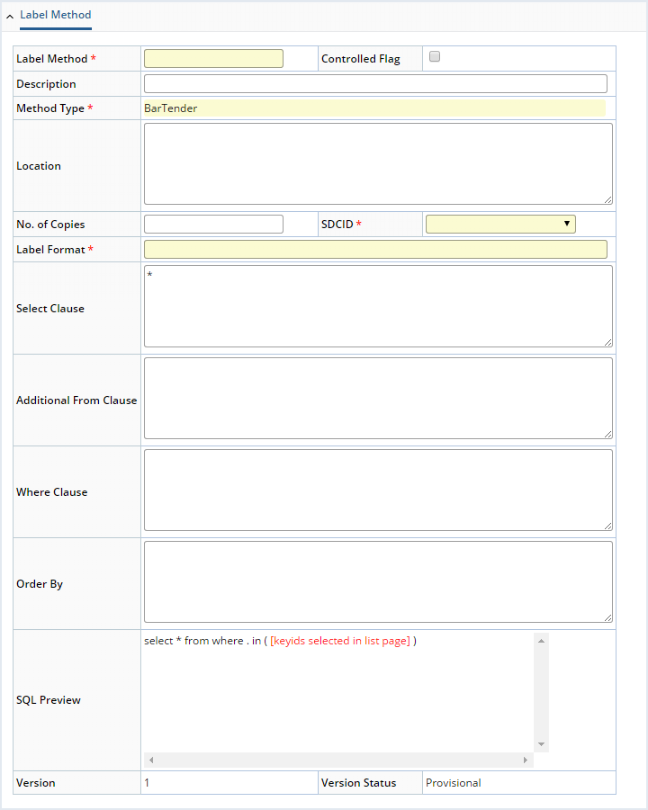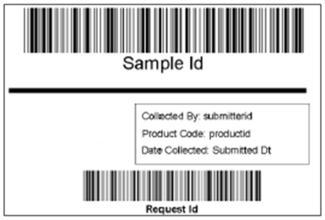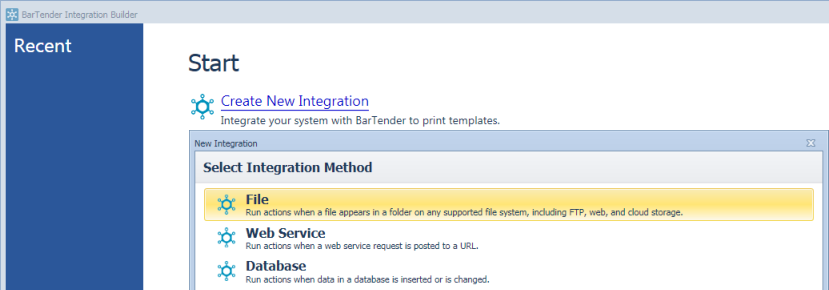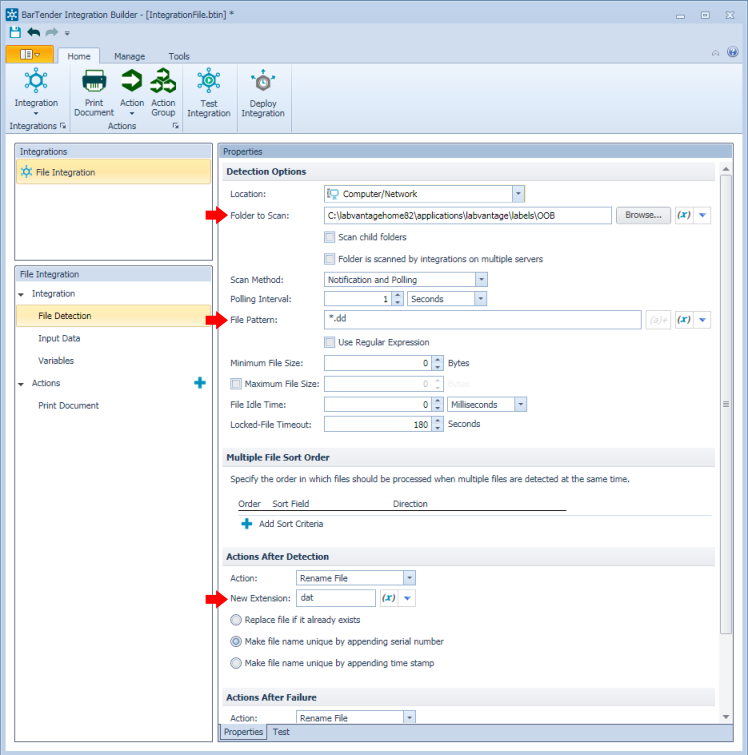Bartender Integration |
|
|
LabVantage integrates with Seagull Scientific Bartender label and barcode printing software to generate barcode labels for various LabVantage SDIs (such as Samples). Bartender is not included with the LabVantage license. Bartender is fully documented by Seagull Scientific at https://www.seagullscientific.com. Bartender 2016 uses the "Integration Builder" in Enterprise Automation Editions.
This is a high level description of how LabVantage integrates with Bartender:
| 1. | Create a Label Method in LabVantage.
The Label Method defines data to be retrieved from LabVantage and put onto
the label, the location of the Bartender Template, the location where
the output file is written, and other administrative controls for the
label.
Label Methods can be Versioned. They can also designate that a Label Event is generated when LabVantage prints a label. This lets you track printing of the Label, and require that a user confirm the success or failure of a printing event. |
| 2. | Choose an OOB Label Template, or create a Bartender Template. When you create your own Template, Bartender creates a .btw file that defines how the information retrieved by the Label Method is printed on the label (such as where the text is displayed, what fields represent the barcode, and images on the label). |
| 3. | Create a Printer in LabVantage. This
is the Printer SDI that will be used in the label printing process. Printers
should be defined using a UNC path to the Printer. The server that executes
the print job (such as the server running the Bartender and its integration
software) must have access to this network location.
Label printing can be enabled for any LabVantage SDC. This functionality works through execution of the GenerateLabel Action, which interprets information from the Label Method (and potentially some user inputs such as printer and copies), and generates a .dd file containing information required for printing. |
| 4. | Bartender Integration software polls a directory and executes the instructions in the .dd file, resulting in the label being printed. |
The information in this document is provided to help users setup the basic LabVantage and Bartender components to print a label. Additional information and details on how to use Bartender can be found at https://www.seagullscientific.com.
Label Methods |
|
|
A "Label Method" defines this information concerning a label:
| Information | Description |
| Data | The Label Method issues a SQL query for an SDC. The query results are sent to Bartender (via the GenerateLabel Action) to print the label. |
| Template | Each Label Method specifies a Bartender Template used to format the label. |
| Label Event | The Label Method determines whether or not a Label Event is generated when a label is printed. |
Label Methods are accessed from System Admin → Reporting → Label Methods, which renders the Label Method List page:
|
|
The Label Method Maintenance form below includes a standard toolbar for a Versioned SDC.
|
|
| Field | Description |
| Label Method | Identifier of the Label Method. |
| Description | Description of the Label Method. |
| Method Type | Currently, only "Bartender" is supported. |
| Location | Location where the DD file is written. This should be defined by a UNC path in enterprise-level deployments. If left blank, this defaults to LABVANTAGE_HOME\APPLICATION_HOME\labels. |
| No. of Copies | Number of labels to print. |
| SDC Id | SDC to be queried. |
| Label Format | Location of the Bartender Template file (.btw). This should be defined by a UNC path in enterprise-level deployments. |
| Version | Version number of the Label Method. |
| Version Status | Version Status of the Label Method. |
| Controlled Flag | When checked, a Label Event is generated when a label is printed. |
These fields define the SQL statement that queries the SDC to get the data that will be printed on the label:
| Select Clause |
SELECT portion of the SQL query that retrieves data for the label.
This defines the columns that will be available for use in the Bartender
Template.
The [currentuser] variable is supported. For example, this select clause results in [currentuser] being substituted in the .dd file with the UserId of the current User: s_sampleid, submitterid, productid, submitteddt, requestid, batchid, '[currentuser]' generatedby |
| Additional From Clause | Additional FROM clause. |
| Where Clause | WHERE clause. |
| Order By | ORDER BY clause. |
| SQL Preview | Displays the SQL statement you have created with these clauses. |
Note that some of these attributes (such as number of copies) can be configured to be overridden at print time by prompting the user.
Printers |
|
|
Printers used for barcode and label printing are maintained through System Admin → Reporting → Printers.
Printing Labels |
|
|
Labels can be configured to print for any SDC. The LabVantage OOB configuration contains the preconfigured Label Methods shown in the Label Method List page. For example, "Sample Label" is a preconfigured OOB Label Method. On the Sample List pages supporting these SDCs, use the "Print Label" button to print a label for the selected Sample. A dialog prompts you for the "Label Method", "Printer" and "Number of Labels to Print" (defaults to 1). Choose values for these. Note that the "Label Method" is filtered to show the relevant SDI.
|
|
After clicking OK, a .dd file is written to the appropriate location. The Integration Builder then detects the file, launches Bartender, and initiates the print job. Here is an example output .dd file and the label it generates:
| Output .dd File
|
| Label
|
Label Events |
|
|
Overview |
If "Controlled Flag" is checked on the Label Method Maintenance page, the Label becomes a "Controlled Label". This means that a "Label Event" is generated whenever the label is printed. The event records this information in the LabelEvent table:
| • | The user who triggered it. | • | What happened as a result of the event. | |
| • | When it was triggered. | • | The SDIs recorded in the report. |
Label Events are generated with a status of "Scheduled".
Label Events List |
Access |
Label Events are accessed from the LIMS → Reports → Label Events menu, which opens the Label Events List page:
|
|
| Column | Description |
| Event Id | Automatically generated key for the Label Event. |
| Reprint From | Label Event from which the reprint is done. |
| Reprint Count | Number of copies reprinted. |
| Date | Date the Label Event was triggered. |
| Method | Label Method used for the label. |
| Printer | Copies the value of the Printer selected when printing labels. |
| Copies | Number of copies printed. |
| Verify Status | See Verifying Label Events below. |
| SDC | SDC Type. |
| Items | Trackitem for which the Label was generated. |
| CreatedBy | User who triggered the Label Event. |
Reprinting Labels |
Clicking "Regenerate Label" invokes an ESig. After ESig verification, the label is reprinted by repeating the Label Event.
Verifying Label Events |
Clicking "Verify" changes the Label Event status to "Verified". This serves no other purpose (it is only a notification).
Bartender Templates |
|
|
Bartender lets you define a label Template from various data sources. Since LabVantage uses a file-based approach with the Bartender Integration software, Templates should be defined in Bartender with a file as the data source. The easiest way to accomplish this is to take a generated .dd file and remove the first three header lines (up to the %END%). Use the remaining part of the file as the database/data source.
For complete details, see the Bartender 2016 documentation at http://help.seagullscientific.com/2016/en/. In general:
| 1. | Select Create New Integration → Database → Database Connection Setup. This launches the wizard to walk you through setting up the data source. Select the following prompts through the wizard. |
| 2. | Select "Text File", then choose your file. Leave the default "Encoding" as "Windows System Default". |
| 3. | For "Field Separation", choose "Tab" (LabVantage uses tabs as the separator between fields in the .dd file). |
| 4. | For "Field Names", the first row header is typically used. |
| 5. | Click "Finish". You can now use Bartender to design the label with
the contents/data from the file.
When saving the Template (.btw file), save to the location defined by your Label Method. |
Note that you can also use one of the OOB Label Methods provided with LabVantage. Each references the corresponding Bartender label file in this location. A few examples are shown below in LABVANTAGE_HOME\APPLICATION_HOME\labels.
|
APPLICATION_HOME |
|
|
|
labels |
|
|
|
|
|
OOB |
|
|
|
|
|

|
BBSampleLabel.btw |
|
|
|
|
|

|
BoxLabelSUID.btw |
|
|
|
|
|

|
SampleLabel.btw |
|
|
|
|
|

|
StabilitySampleLoadLabel.btw |
|
|
|
|
|

|
StabilitySamplePullLabel.btw |
|
Setting Up Integrations |
|
|
Integrations tell Bartender how to process a file and where to look for new files. For complete details, see the Bartender 2016 documentation at http://help.seagullscientific.com/2016/en/. In general:
| 1. | Start the Integration Builder. | |
| 2. |
Create a new File Integration (Create New Integration → Select
Integration Method → File).
|
|
| 3. | Setup Detection Options (File Integration → File Detection →
Detection Options) as shown in the screen below. The "Folder To Scan"
should be set to where you write your .dd files (typically the labels
folder in LABVANTAGE_HOME\APPLICATION_HOME\labels).
|
|
| 4. | Delete "Print Document" under "Actions" (below
left). Add a new Action, then select "Print Command Script"
(below right) and setup the properties as desired.
|
|
| 5. | Save, then Test or Deploy the Integration. |
Seagull License Server |
|
|
The Seagull License Server is used to administer the Bartender applications from a licensing perspective, and allows customers to print to a number of printers on their network (as defined by the licensing level purchased). See the Seagull License Server documentation concerning the setup of this application.








